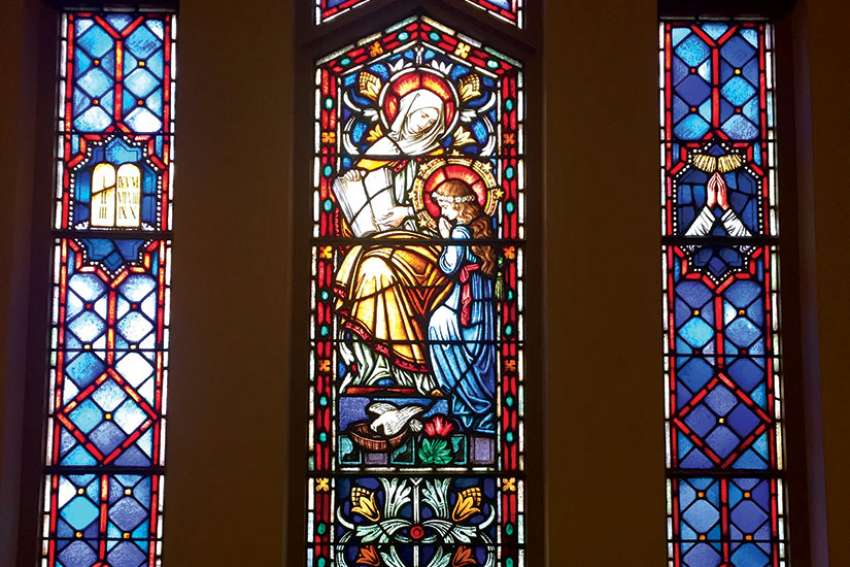If not, make it a Lenten project to take a look. Find the stained glass window you like best or one that amazes you, and reflect on what the image is saying.
Stained glass windows contribute to the beauty of a place of worship. They can represent a great deal of narrative information about our faith. They can also be a starting point to prayer, meditation and contemplation.
During Lent, when we are asked to turn towards God in preparation for Easter, prayer and meditation allow us to open ourselves to the divine purpose of God in our lives.
Our Lady of Peace parish in Etobicoke has 10 amazingly beautiful stained glass windows in the nave. All are on a blue background, a colour often associated with Mary, the Mother of God. All of them were made in 1959 by Nicholas Wagner of Stained Glass Windows, Mosaics, Church Interiors representing Franz Mayer and Co. (Pontifical Institute of Christian Art) in Munich.
Several Roman Catholic churches around the world are named after the Mother of Jesus, but Our Lady of Peace Church may be unique in that all its stained glass windows are dedicated to events in the life of Mary.
One such window depicts a woman holding a book for a young girl. Searching the parish archives, I found the title of the window: “St. Anne teaching Mary.”
The window is the only one in the church showing an event in the life of the Virgin as a young girl with her mother. There is no biblical account of the life of Mary until her engagement to Joseph (Mt. 1:18). Therefore, I wondered about the intention of the artist and what his artwork might be telling worshippers.
In the window, a seated St. Anne is holding an open book in front of a kneeling Mary in a prayer posture. Are they meditating on the word of God? The colour of Mary’s dress is blue with a red cloth around her waist and she wears a tiara. The colour of her mother’s dress is yellow and she wears a white head scarf.
Mary and St. Anne both have halos of the same bright red. A dove is at the bottom of the frame. The book St. Anne holds has some inscriptions which are not legible. Like the other nine stained glass windows in the nave, the window of St. Anne and Mary also has two smaller window panes on each side of the main window.
The smaller window pane on the left shows an opened book with Roman numerals from 1 to 10; the other pane shows two hands joined together in prayer. With this information, it appears that the artist intended to give us a clue to what St. Anne is teaching her daughter — God’s Torah.
At that time, Scriptures indicate women were not allowed to read or to teach the Torah. This task was reserved for a few men who were leaders in Jewish communities. We might expect that the father of Mary would perform this duty, but he was left out, seemingly unimportant to the artist.
My reflection on the window led me to see the picture as representing St. Anne as a teacher who was versed in the Torah. Through her teaching the word of God to her daughter, St. Anne prepared her daughter Mary for her future role as a servant of God.
The window also speaks to us about our own journey as people called to serve. The season of Lent calls us to return to God through spiritual exercises of reading and meditation on the word of God, praying with the word of God and our desire to follow the precepts of the Lord.
This Lenten season, find some time to gaze at a stained glass window that amazes you. Reflect and meditate on it during your journey in Lent. You will be amazed at what that window will say to you about your own journey as a servant of God.
(Fr. Yaw Acheampong is Pastor at Our Lady of Peace in Toronto, Ont.)


